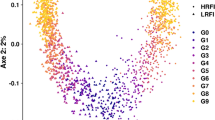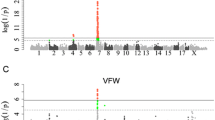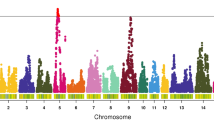Abstract
It is well known that TRX and its endogenous inhibitor TXNIP help sustain the cellular reduction/oxidation balance in response to various stresses and both play a crucial role in cell proliferation and growth. Five SNPs were found in TXNIP and these allowed us to map it by linkage to SSC4. Three of the SNPs were used for association analyses in three commercial pig populations (Duroc, Hampshire, and synthetic line) with more than 1200 animals. Both the single-marker and haplotype analyses revealed significant effects of TXNIP on hot carcass weight, test daily gain, and lifetime daily gain. TRX was mapped on SSC1 but no significant associations with growth-related traits were found in the synthetic pig line in which the SNP was informative. The expression levels of TXNIP and TRX were then detected in two groups (fast growth and slow growth, respectively) with different genetic backgrounds for growth. Compared with the slow-growth group, TXNIP expression was significantly lower in the fast-growth group, whereas a marked increase in TRX expression was observed in fast-growth group. Our findings suggest that TXNIP has effects on growth-related traits in pigs and further investigations will be necessary to elucidate the underlying mechanisms involved.




Similar content being viewed by others
References
Bidanel JP, Milan D, Iannuccelli N, Amigues Y, Boscher MY, et al. (2001) Detection of quantitative trait loci for growth and fatness in pigs. Genet Sel Evol 33, 289–309
Bieche I, Champeme MH, Lidereau R (1995) Loss and gain of distinct regions of chromosome 1q in primary breast cancer. Clin Cancer Res 1, 123–127
Brambilla G, Civitareale C, Ballerini A, Fiori M, Amadori M, et al. (2002) Response to oxidative stress as a welfare parameter in swine. Redox Rep 7, 159–163
Bruun CS, Jørgensen CB, Nielsen VH, Andersson L, Fredholm M (2006) Evaluation of the porcine melanocortin 4 receptor (MC4R) gene as a positional candidate for a fatness QTL in a cross between Landrace and Hampshire. Anim Genet 37, 359–362
Butler LM, Zhou X, Xu WS, Scher HI, Rifkind RA, et al. (2002) The histone deacetylase inhibitor SAHA arrests cancer cell growth, up-regulates thioredoxin-binding protein-2, and down-regulates thioredoxin. Proc Natl Acad Sci USA 99, 11700–11705
Cepica S, Stratil A, Kopecny M, Blazkova P, Schröffel J Jr, et al. (2003) Linkage and QTL mapping for Sus scrofa chromosome 4. J Anim Breed Genet 120, 28–37
Chen KS, DeLuca HF (1994) Isolation and characterization of a novel cDNA from HL-60 cells treated with 1,25-dihydroxyvitamin D-3. Biochim Biophys Acta 1219, 26–32
Dietz KJ, Scheibe R (2004) Redox regulation: an introduction. Physiol Plant 120, 1–3
Excoffier L, Slatkin M (1995) Maximum-likelihood estimation of molecular haplotype frequencies in a diploid population. Mol Biol Evol 12, 921–927
Filby CE, Hooper SB, Sozo F, Zahra VA, Flecknoe SJ, et al. (2006) VDUP1: a potential mediator of expansion-induced lung growth and epithelial cell differentiation in the ovine fetus. Am J Physiol Lung Cell Mol Physiol 290, 250–258
Geldermann HE, Muller G, Moser G, Reiner H, Bartenschlager S, et al. (2003) Genome-wide linkage and QTL mapping in porcine F2 families, J Anim Breed Genet 120, 363–393
Green P, Falls K, Crooks S (1990) Documentation for CRIMAP, version 2.4. (St Louis, MO: Washington University School of Medicine)
Heppell-Parton A, Cahn A, Bench A, Lowe N, Lehrach H, et al. (1995) Thioredoxin, a mediator of growth inhibition, maps to 9q31. Genomics 26, 379–381
Ikarashi M, Takahashi Y, Nagata T, Ishii Y, Ishikawa K, et al. (2002) Vitamin D3 up-regulated protein 1 (VDUP1) expression in gastrointestinal cancer and its relation to stage of disease. Anticancer Res 22, 4045–4048
Jackson MJ (2005) Reactive oxygen species and redox-regulation of skeletal muscle adaptations to exercise. Philos Trans R Soc Lond B Biol Sci 360, 2285–2291
Junn E, Han SH, Im JY, Yang Y, Cho EW, et al. (2000) Vitamin D3 up-regulated protein 1 mediates oxidative stress via suppressing the thioredoxin function. J Immunol 164, 6287–6295
Keung YK, Yung C, Wong JW, Shah F, Cobos E, et al. (1998) Unusual presentation of multiple myeloma with “jumping translocation” involving 1q21. A case report and review of the literature. Cancer Genet Cytogenet 106, 135–139
Kim KS, Larsen N, Short T, Plastow G, Rothschild MF (2000) A missense variant of the porcine melanocortin 4 receptor (MC4R) gene is associated with fatness, growth, and feed intake traits. Mamm Genome 11, 131–135
Knott SA, Marklund L, Haley CS, Andersson K, Davies W, et al. (1998) Multiple marker mapping of quantitative trait loci in a cross between outbred wild boar and large white pigs. Genetics 149, 1069–1080
Kozak M (1987) An analysis of 5V-noncoding sequences from 699 vertebrate messenger RNAs. Nucleic Acids Res 15, 8125–8148
Ludwig DL, Kotanides H, Le T, Chavkin D, Bohlen P, et al. (2001) Cloning, genetic characterization, and chromosomal mapping of the mouse VDUP1 gene. Gene 269, 103–112
Malek M, Dekkers JCM, Hakkyo KL, Baas TJ, Rothschild MF (2001) A molecular genome scan analysis to identify chromosomal regions influencing economic traits in the pig: I. Growth and body composition. Mamm Genome 12, 630–636
Matsushima Y, Nanri H, Nara S, Okufuji T, Ohta M, et al. (2006) Hindlimb unloading decreases thioredoxin-related antioxidant proteins and increases thioredoxin-binding protein-2 in rat skeletal muscle. Free Radic Res 40, 707–714
Medvedev A, Chistokhina A, Hirose T, Jetten AM (1997) Genomic structure and chromosomal mapping of the nuclear orphan receptor ROR gamma (RORC) gene. Genomics 46, 93–102
Menon SG, Goswami PC (2006) A redox cycle within the cell cycle: ring in the old with the new. Oncogene 26, 1101–1109
Minn AH, Hafele C, Shalev A (2005) Thioredoxin-interacting protein is stimulated by glucose through a carbohydrate response element and induces beta-cell apoptosis. Endocrinology 146, 2397–2405
Nishinaka Y, Nishiyama A, Masutani H, Oka S, Ahsan KM, et al. (2004) Loss of thioredoxin-binding protein-2/vitamin D3 up-regulated protein 1 in human T-cell leukemia virus type I-dependent T-cell transformation: implications for adult T-cell leukemia leukemogenesis. Cancer Res 64, 1287–1292
Nishiyama A, Matsui M, Iwata S, Hirota K, Masutani H, et al. (1999) Identification of thioredoxin-binding protein-2/vitamin D(3) up-regulated protein 1 as a negative regulator of thioredoxin function and expression. J Biol Chem 274, 21645–21650
Patwari P, Higgins LJ, Chutkow WA, Yoshioka J, Lee RT (2006) The interaction of thioredoxin with txnip: evidence for formation of a mixed disulfide by disulfide exchange. J Biol Chem 281, 21884–21891
Perez-Enciso M, Clop A, Noguera JL, Ovilo C, Coll A, et al. (2000) A QTL on pig chromosome 4 affects fatty acid metabolism: evidence from anIberian by Landrace intercross. J Anim Sci 78, 2525–2531
Powis G, Montfort WR (2001) Properties and biological activities of thioredoxins. Annu Rev Pharmacol Toxicol 41, 261–295
Prestridge DS (1995) Predicting Pol II promoter sequences using transcription factor binding sites. J Mol Biol 249, 923–932
Sauerwein H, Schmitz S, Hiss S (2005) The acute phase protein haptoglobin and its relation to oxidative status in piglets undergoing weaning-induced stress. Redox Rep 10, 295–302
Schulze PC, De Keulenaer GW, Yoshioka J, Kassik KA, Lee RT (2002) Vitamin D3-upregulated protein-1 (VDUP-1) regulates redox-dependent vascular smooth muscle cell proliferation through interaction with thioredoxin. Circ Res 91, 689–695
Takahashi Y, Nagata T, Ishii Y, Ikarashi M, Ishikawa K, et al. (2002) Up-regulation of vitamin D3 up-regulated protein 1 gene in response to 5-fluorouracil in colon carcinoma SW620. Oncol Rep 9, 75–79
Taketo M, Matsui M, Rochelle JM, Yodoi J, Seldin MF (1994) Mouse thioredoxin gene maps on chromosome 4, whereas its pseudogene maps on chromosome 1. Genomics 21, 251–253
Wang Y, De Keulenaer GW, Lee RT (2002) Vitamin D(3)-up-regulated protein-1 is a stress-responsive gene that regulates cardiomyocyte viability through interaction with thioredoxin. J Biol Chem 277, 26496–26500
Watson WH, Yang X, Choi YE, Jones DP, Kehrer JP (2004) Thioredoxin and its role in toxicology. Toxicol Sci 78, 3–14
Wernersson R, Schierup MH, Jørgensen FG, Gorodkin J, Panitz F, et al. (2005) Pigs in sequence space: A 0.66X coverage pig genome survey based on shotgun sequencing. BMC Genomics 6, 70
Yamawaki H, Berk BC (2005) Thioredoxin: a multifunctional antioxidant enzyme in kidney, heart and vessels. Curr Opin Nephrol Hypertens 14, 149–153
Yang X, Young LH, Voigt JM (1998) Expression of a vitamin D-regulated gene (VDUP-1) in untreated and MNU-treated rat mammary tissue. Breast Cancer Res Treat 48, 33–44
Yegorova S, Yegorov O, Lou MF (2006) Thioredoxin induced antioxidant gene expressions in human lens epithelial cells. Exp Eye Res 83, 783–792
Yoshioka J, Schulze PC, Cupesi M, Sylvan JD, MacGillivray C, et al. (2004) Thioredoxin-interacting protein controls cardiac hypertrophy through regulation of thioredoxin activity. Circulation 109, 2581–2586
Acknowledgments
This work was funded in part by Genus, PIC USA, the Iowa Agriculture and Home Economics Experiment Station, and State of Iowa and Hatch funds. Technical assistance from Ms. Kimberly Glenn and Drs. S. Lonergan and C. Stahl is appreciated.
Author information
Authors and Affiliations
Corresponding author
Rights and permissions
About this article
Cite this article
Yu, M., Geiger, B., Deeb, N. et al. Investigation of TXNIP (thioredoxin-interacting protein) and TRX (thioredoxin) genes for growth-related traits in pigs. Mamm Genome 18, 197–209 (2007). https://doi.org/10.1007/s00335-007-9006-8
Received:
Accepted:
Published:
Issue Date:
DOI: https://doi.org/10.1007/s00335-007-9006-8




